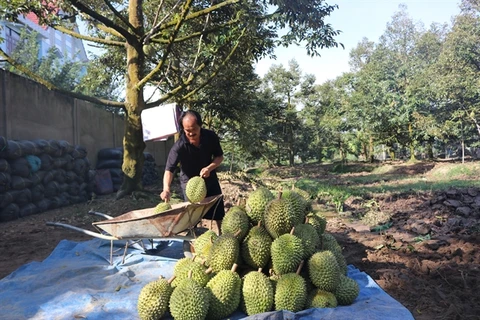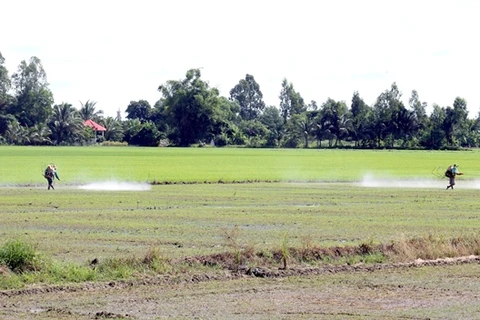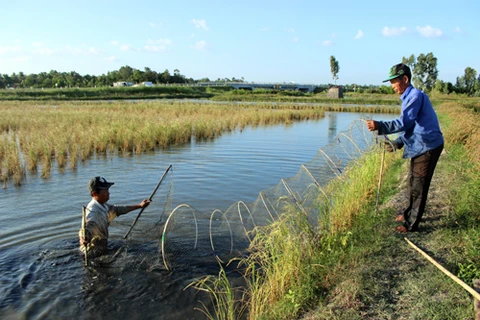Long An (VNS/VNA) - The Mekong Delta province of Long An plans to increase its rate of high-quality rice cultivation to 70 -75 percent during 2021 – 2025 from the current 50 percent, according to its Department of Agriculture and Rural Development.
It aims to produce 2.5 million tonnes of grain annually during the period.
Nguyen Thanh Truyen, director of the department, said to achieve the targets advocacy of environmental protection and improving the quality of agricultural produce would be undertaken.
The province would speed up construction of irrigation works like water pumping stations, ditches in crop fields and saltwater prevention sluices, research and create suitable sowing schedules, identify rice varieties to be grown in each locality, and organise courses to train farmers in farming techniques, he said.
It will focus on implementing an existing programme to develop high-tech agriculture and increase its high-tech rice farming area from the current 20,000ha to 60,000ha by 2025.
Last year, the province produced 2.8 million tonnes of rice, including some high-quality varieties like Dai Thom 8, OM 4900, Nang Hoa 9, ST24, and ST25.
ST25 won the first prize at the 2019 World’s Best Rice Contest.
In 2013, the province zoned more than 48,000ha for growing high – quality varieties in 25 communes in the Dong Thap Muoi (Plain of Reeds) region to serve exports, improve efficiency and enhance farmers’ incomes.
In these areas, farmers have to use advanced techniques like ‘one must and five reductions’ and ‘three reductions and three increases.’
The former requires farmers to use certified seeds, and reduce seedlings, plant protection chemicals, nitrogen fertilisers, irrigation, and post-harvest losses.
Tran Van Lam, who uses advanced techniques to grow rice in Tan Thanh district’s Bac Hoa commune, said he is able to reduce the use of seeds for sowing by 20 – 50 kilogramme per hectare and fertilisers by 20 – 30 percent compared to traditional methods.
His costs are down by 2 – 2.5 million VND (90 – 110 USD) per hectare while yields are 500 – 800 kg higher, he said.
“The income is 4 – 6 million VND (170 – 260 USD) per hectare higher.”
The high-quality varieties, too, fetch farmers higher incomes.
Le Hoang Phi in Thanh Hoa district’s Tan Dong commune has switched to glutinous rice variety IR 4625 in his 1.5ha field because of its high quality, resistance to diseases and steady demand and price.
He uses technology, organic fertilisers and bio-products to meet market demand and earns 50 million VND (2,160 USD) a year, he said.
Long An is expected to have 498,300ha under rice this year, slightly down from last year, according to the department.
The average rice yield is expected to be 140kg higher than last year at 5.6 tonnes per hectare./.
It aims to produce 2.5 million tonnes of grain annually during the period.
Nguyen Thanh Truyen, director of the department, said to achieve the targets advocacy of environmental protection and improving the quality of agricultural produce would be undertaken.
The province would speed up construction of irrigation works like water pumping stations, ditches in crop fields and saltwater prevention sluices, research and create suitable sowing schedules, identify rice varieties to be grown in each locality, and organise courses to train farmers in farming techniques, he said.
It will focus on implementing an existing programme to develop high-tech agriculture and increase its high-tech rice farming area from the current 20,000ha to 60,000ha by 2025.
Last year, the province produced 2.8 million tonnes of rice, including some high-quality varieties like Dai Thom 8, OM 4900, Nang Hoa 9, ST24, and ST25.
ST25 won the first prize at the 2019 World’s Best Rice Contest.
In 2013, the province zoned more than 48,000ha for growing high – quality varieties in 25 communes in the Dong Thap Muoi (Plain of Reeds) region to serve exports, improve efficiency and enhance farmers’ incomes.
In these areas, farmers have to use advanced techniques like ‘one must and five reductions’ and ‘three reductions and three increases.’
The former requires farmers to use certified seeds, and reduce seedlings, plant protection chemicals, nitrogen fertilisers, irrigation, and post-harvest losses.
Tran Van Lam, who uses advanced techniques to grow rice in Tan Thanh district’s Bac Hoa commune, said he is able to reduce the use of seeds for sowing by 20 – 50 kilogramme per hectare and fertilisers by 20 – 30 percent compared to traditional methods.
His costs are down by 2 – 2.5 million VND (90 – 110 USD) per hectare while yields are 500 – 800 kg higher, he said.
“The income is 4 – 6 million VND (170 – 260 USD) per hectare higher.”
The high-quality varieties, too, fetch farmers higher incomes.
Le Hoang Phi in Thanh Hoa district’s Tan Dong commune has switched to glutinous rice variety IR 4625 in his 1.5ha field because of its high quality, resistance to diseases and steady demand and price.
He uses technology, organic fertilisers and bio-products to meet market demand and earns 50 million VND (2,160 USD) a year, he said.
Long An is expected to have 498,300ha under rice this year, slightly down from last year, according to the department.
The average rice yield is expected to be 140kg higher than last year at 5.6 tonnes per hectare./.
VNA























